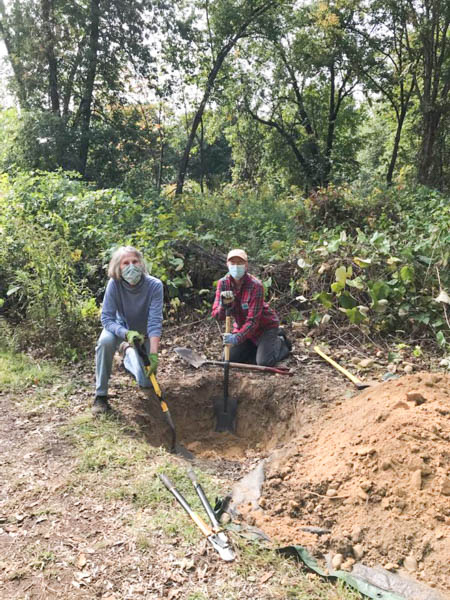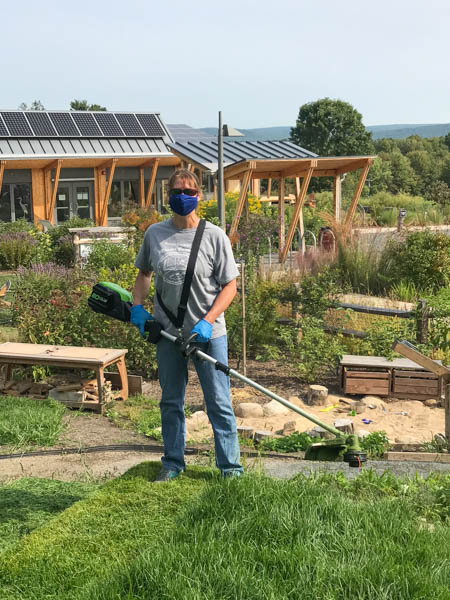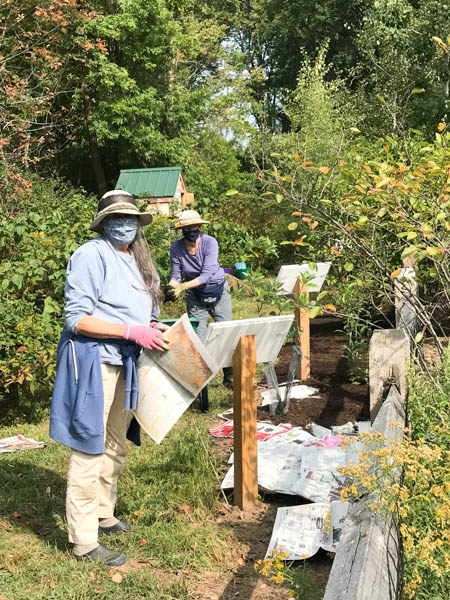by Bridgit Litchfield, volunteer and master gardener
What a soul-satisfying pleasure it is to share gardening tasks with other volunteers and work-study students from the local colleges. We have fun, laugh and get much accomplished while everyone’s ideas are sought, discussed and respected. Each comes to help with the Hitchcock Center’s mission — to educate and motivate into action citizens of all ages and abilities to become environmentally sound stewards of nature.

Priscilla White and Bridgit Litchfield work in the garden. PHOTO Shelly Kahan
In the Hitchcock gardens, that mission is being carried out with ongoing installations of native plants tended by using only organic methods. This is especially necessary for the pollinators and for teaching humans about the interdependence of each and every species specific to a habitat.
Many of the larger pollinator gardens are part of the play yards in which children and families can use all their senses to enjoy the flowers and observe the pollinators and other insects dependent on the plants. Our gardens show visitors how attractive native plants can be, especially when they are bringing an ecosystem back to health. Anyone with a yard can do this too!
The gardening year of 2020 started in February with late winter pruning of still dormant trees and shrubs. Each pruner delighted in spotting and conserving overwintering praying mantis egg cases on twigs and other wooden surfaces.
Despite the fact that student volunteers were sent home abruptly from college in mid-March due to the pandemic (and couldn’t return until late August), it wasn’t long before a few terrific high school students came to volunteer since we all wore masks and distanced.
New gardeners learned that very drought-tolerant plants in the xeriscape garden, such as prickly pear and nodding onions, only need to be watered once each month despite their location under the front door eave, which prevents natural rain from reaching them. These plants are watered with rainwater collected in rain barrels around the site.

Natalie Long helps trim the grass. PHOTO Shelly Kahan
One hot, late July morning, it was just Priscilla White, two students, and me edging some beds, gradually working our way toward the large, sunken area known as the mud kitchen. During rainy periods it holds water, creating a small pool that drains slowly to leave lots of mud for children’s creative play. For health safety, the outdoor play areas were not yet open to the public, so the mud kitchen had remained totally weedy on purpose to discourage play there. The waist-high weeds were dense and robust in an area about eight feet square. Working together, we got the mud kitchen weed free in just an hour, in preparation for a teacher workshop on erosion the following week.
Early one evening, a strange thing happened which I have never seen before. It was the time of early fall when new queen bumblebees mate and dig a burrow into soft earth to overwinter while retaining sperm to fertilize their eggs next year. Four of us were spread out in a well-mulched flower bed pulling out the horribly invasive, non-native mugwort that was overtaking the native flowers. Much to our surprise and dismay, a normally docile bumblebee (was she unearthed by the weeding?) started repeatedly bouncing off Gwen’s pony tail aggressively. No amount of shooing could stop it. Poor Gwen did a lap around the parking lot to finally lose it and we moved into another garden. But not fast enough – each one of us had a turn being chased by that queen pouncing on our hair. Luckily, no one was stung and the queen finally left.
Hitchcock staff member Jeff Mazur entrusted us with planting a couple of tender, one-year-old chestnut trees he grew from seed. We were excited imagining future generations enjoying massive chestnut trees located in the meadow at a safe distance from the building. We lovingly spread the roots out at just the right depth in the holes, backfilled pressing carefully, then made a ring of extra soil above ground level wider than the root zone to create a shallow water-retaining well.

Deb Jacobs and Kendall Clark help prep garden beds. PHOTO Shelly Kahan
Grace watered the trees and Kelly mulched to discourage winter annual weeds from germinating. I was planning to bring some metal window screen to fashion a protective sleeve around the tiny saplings in a few days — typically groundhogs, voles and rabbits take a while to find a new planting. But, imagine our unhappiness when we found the smaller tree completely gone and the larger one reduced by half with the distinctive, clean angular cut of a rabbit’s bite. It was not fun breaking the news to Jeff. Moral: do not leave a newly planted tree without rodent protection for even a minute!
That experience prompted me to bring out all the organic animal repellents I own to teach the volunteers to read labels carefully, especially ingredients and directions. Everyone laughed at the common ingredient of putrefied egg solids, often mixed with oils of garlic, clove and mint. Some did dare to take a whiff after I did and all practiced sprinkling and spraying the many low-bush blueberries I had taught them to transplant; they were showing evidence of rabbit damage.
Priscilla and I are often inspired by and marvel at the excellent work ethic, communication skills, sincerity, politeness and enthusiasm that these young adults bring to their gardening jobs as well as their studies and dreams. They are thoughtful and caring with each other, with us, and with the natural environment. It’s heart-warming and refreshing, giving us hope for the future.
Emulating the Hitchcock Center staff who are always expressing their gratitude for us, I praise and thank the volunteers every session for their efforts in making the landscape healthy and lovely. I’m delighted that this year’s gardeners all hope to return for pruning in February 2021.
Here are some of the feelings of the gardeners in their own words:
“What I love most about being in the gardens is how freeing it feels.
When I’m working, I feel like I can be myself, unconstrained, alive, and
free of worry. I feel like I am enjoying the planet in the most raw,
beautiful way possible. “
– Gabriel David Whitney
“I’ve loved being a part of the stewardship of the many creative expressions of the natural world at Hitchcock, like pollinator gardens, erosion based mud kitchens, and sustainable ecosystems. Under the supervision of master gardener Bridgit [Litchfield], it’s been fun to learn about the life cycle of the plants and trees, what threats they face, and how, as volunteer gardeners, we can contribute to their health and the health of our planet.”
– Priscilla White
“Gardening at the Hitchcock Center has given me the unique opportunity as a student to learn more about the natural world around me while also helping the cause for a clean environment. This sort of experience is incredibly valuable to me and so many others.”
– Raghav Surya
“Volunteering at the Hitchcock center with Grace has been such a pleasure. We have learned so much from Bridgit and we love seeing tangible results each and every time we are there! We feel grateful to be able to participate in sustainability, community and keeping things tidy!! “
– Kelly Jarvis
“Volunteering in the gardens at the Hitchcock Center was an amazing experience. The people there are so kind and welcoming and are great advocates for the Earth and its natural beauty. We had a great time even working through the rain and chilly mornings. We spent time transplanting low bush blueberries and learning all about different plants and even getting to experience the pleasant scent of some of them. We weeded, mulched and cleared out some of the excess brush. Thank you! I had a wonderful time with you all this past month!”
– Allie Hoschtetler
“It’s a privilege to express some thoughts of mine, thank you for giving us the opportunity! In my opinion, working on and being within gardens is a source of magic on earth, no wands or spells required. Gardens create a space that transcends so many of the socially constructed boundaries that obstruct our unity as human beings. Spaces such as the Hitchcock Center have the ability to demonstrate the precious and beautiful nature of all life while showing appreciation for our planet that is neglected in far too many other forms. As inhabitants of this earth it is part of our responsibility to learn the delicate dance of nourishing and giving back in capacities that we are able, and the women I have volunteered with thus far are teaching me some extraordinary steps. It’s difficult to express this magic of nurturing life, dirty hands, and sustainable practices without the space and guidance for such experiences, making the Hitchcock Center for the Environment an invaluable resource in many more ways than one. I feel incredibly lucky to have become involved as a volunteer and meet all of you empowering women, and I’m looking forward to more experiences and adventures in the new year.”
– Molly Powers
“Working at the Hitchcock Center has been so enriching and relaxing. It’s a beautiful
space that I have a lot of care for and enjoy tending to. It has a
community-driven feeling to it that I love being a part of. It’s so
meaningful to see kids playing in the areas I’ve worked to make green
and healthy, and to personally learn more about the environment I’m in.The HCE’s emphasis on cultivating local and native plants has felt
especially important to me as a connection with the land. I’ve loved
getting to know which flowers the bees like best. It’s also been
wonderful getting to know the staff and other volunteers. I’ve learned
so much from them!”
– Isabel Adriana Bate
“As someone who loves being outside and hopes to study plants in college, gardening at Hitchcock has been a wonderful way to contribute to making a beautiful learning environment for the community and getting to collaborate with kind, like-minded people.”
– Jana Murphy
“What I enjoyed about working in the gardens was learning about landscaping and plant care. I learned to spread the proper amount of mulch around shrubs and trees. I learned about desert gardens and rain gardens; I got to water the plants with rainwater that fell onto the roof. I also just loved the peacefulness of the gardens, and weeding in the afternoon in the company of good folks, watching children climb the wood piles and classes learn about earthworms and acorns. I enjoyed the independence I had with some of the projects I worked on, including filling a hole where a new oak tree was planted and creating a mud moat and dam so the water wouldn’t wash away. I liked transplanting blueberries and the satisfying feeling of weeding a bed clean. It is restful to be in the gardens and good to engage my body and distract my worrying, thinking school-mind. I am glad to contribute to this community at the Hitchcock Center and get to work in this little patch of green and flowers on the hill!”
– Gwen Peavey Hunter
Share this page with friends!
This is beautiful !! Such positive thoughts and actions during the difficult Covid Era. Wonderful news ! Thanks to you all!
Susan